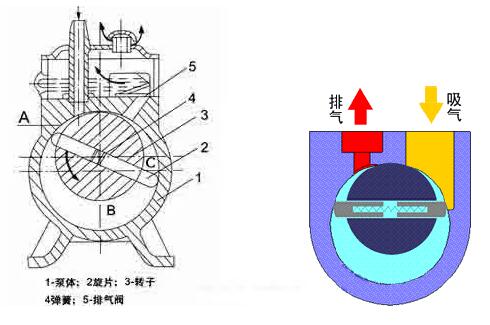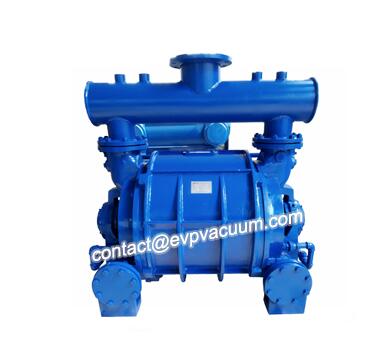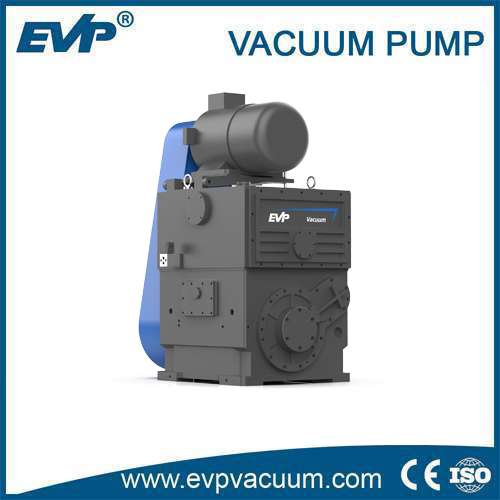Liquid ring vacuum pump description
liquid ring vacuum pumps classification
According to different structures, it can be divided into single-stage single acting liquid ring vacuum pump, single-stage double acting liquid ring vacuum pump, double suction ring vacuum pump and atmospheric liquid ring vacuum pump.
Single stage single acting liquid ring vacuum pump: single stage liquid ring vacuum pump means that there is only one impeller, and single acting means that the suction and exhaust are carried out once for each rotation of impeller. The ultimate vacuum of this pump is high, but the pumping speed and efficiency are low.
Single stage double acting liquid ring vacuum pump: single stage liquid ring vacuum pump means that there is only one impeller, and double acting means that every rotation of the impeller, suction and exhaust are carried out twice. Under the same beating speed, the double acting water ring pump greatly reduces the size and weight compared with the single acting pump. Because the working chamber is symmetrically distributed on both sides of the pump shell, the load on the rotor is improved. This kind of pump has higher pumping speed and efficiency, but lower limit vacuum.
Double suction ring vacuum pump: most of them are single acting pumps connected in series. In fact, the impeller of two single-stage single acting liquid ring vacuum pumps is connected by a common mandrel. Its main feature is that under high vacuum, it still has a large pumping speed, and its working condition is stable.
Atmospheric liquid ring vacuum pump: in fact, it is a unit of water ring pump in series with air ejector. The front of the liquid ring vacuum pump is in series with atmospheric vacuum pump to improve the limit vacuum and expand the scope of application of the vacuum pump.
According to the suction and exhaust mode, it can be divided into axial suction and radial suction and exhaust.
Axial suction and exhaust: the suction and discharge of gas are carried out through the suction and discharge ports on the shell side cover, which has the advantages of simple structure and convenient maintenance. The disadvantage is that when the gas enters and discharges the impeller, the gas flow direction is perpendicular to the movement direction of the impeller blade, and the gas cannot enter and exit the impeller evenly on the whole blade width, which increases the gas entering and leaving the impeller The hydraulic loss of the wheel reduces the efficiency of the pump.
Radial suction and exhaust: the gas enters and exits the impeller through the suction port and exhaust port on the gas distributor set at the inner circle of the impeller (equivalent to the wheel inspection place). The advantage is that the gas can enter and exit the impeller within the full range of the blade, and the gas can enter and exit the impeller in the direction of the impeller and the direction of the impeller movement by virtue of the shape of the suction port and exhaust port In the same way, the hydraulic loss is reduced and the efficiency of vacuum pump is improved. The disadvantages are that the structure of the gas distributor is more complex and the machining and installation accuracy is higher.
liquid ring vacuum pump working principle:

The working principle of liquid ring vacuum pump is shown in the figure, and a proper amount of water is filled in the vacuum pump body as the working fluid. When the impeller rotates clockwise, the water is thrown around by the impeller. Due to the centrifugal force, the water forms a closed ring of approximately equal thickness, which is determined by the shape of the pump cavity. The inner surface of the upper part of the water ring is just tangent to the impeller hub, and the inner surface of the lower part of the water ring is just in contact with the top of the blade (in fact, the blade has a certain insertion depth in the water ring). At this time, a crescent space is formed between the impeller hub and the water ring, and this space is divided into several small cavities with equal number of blades by the impeller. If the upper 0 ° of the impeller is taken as the starting point, the volume of the small cavity will increase from small to large when the impeller is 180 ° before rotation, and it is connected with the suction port on the end face. At this time, the gas will be inhaled, and when the suction is finished, the small cavity will be isolated from the suction port; when the impeller continues to rotate, the small cavity will change from large to small, so that the gas will be compressed; when the small cavity is connected with the exhaust port, the gas will be excluded from the pump. In this way, every time the impeller rotates once, the space between the blades sucks and exhausts once, and many spaces work ceaselessly, and the pump continuously sucks or presses the gas.
When used as a compressor, the exhaust port of the vacuum pump is connected with a gas water separator. The steam water mixture will be separated automatically after entering the gas-water separator. The gas will be delivered to the required system by the exhaust pipe, and the water will be discharged through the automatic overflow switch. When compressing the gas, the working water is very easy to heat, and the water will be discharged from the pump outlet, so the temperature will become higher. Therefore, at the bottom of the gas water separator, cold water should be continuously supplied to supplement the discharged hot water, and at the same time, it will play a cooling role, so that the working water temperature will not be too high, so as to ensure the performance of the compressor, achieve the technical indicators, and meet the process requirements.
To sum up, the liquid ring vacuum pump realizes suction, compression and exhaust by the change of pump cavity volume, so it belongs to variable volume vacuum pump. The difference between gas suction and pressure delivery system is only that the internal structure of gas water separator is different. When pumping gas, the pressure at the suction port is lower than atmospheric pressure, while the pressure at the exhaust port is equal to atmospheric pressure, and there is only overflow pipe in the gas water separator. When the gas is pressurized, the suction port is under normal pressure (or vacuum state), and the pressure of the exhaust port is higher than one atmospheric pressure. To ensure the pressure of the gas, the water level of the gas water separator is controlled by the overflow switch.

Liquid ring vacuum pump description
(The article comes from the Internet. If reprinting is not allowed, please contact our company to delete it.)
Related Products
Contact us
If possible, kindly suggest please your working industry/process, working pressure, working medium, etc. Given detailed request helps to gain better-matched customized solution. Thanks for your patience.
your request will be responsed within 3 hours, kindly pay attention to your email please.




